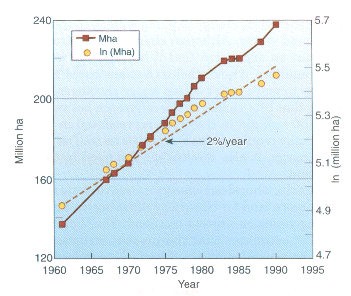




Next: Reasons to hope
Up: Does Water Cloud the
Previous: Irrigation matters
Why worry? Because the ideal sites where streams
freely carry water from snow clad mountains now
may be exploited, the expansion of irrigation
is slowing.
Even fields already irrigated are being abandoned
as levels in wells sink, soils become salty, and
competition for water sharpens. The transfer of water
from irrigation to other uses in Colorado and Arizona
exemplifies competition's impact on irrigation
(Council for Agricultural Science and Technology,
1992[fAST92], 31). The conventional view finds irrigation in
trouble.
 Figure 9.2.1. The cropland irrigated in the world as reported by
ministries of agriculture to the FAO. Solid blocks
and lines mark the rise of the absolute area. The
percentage rise can be judged from the logarithms
shown by circles. A dashed line provides a reference
of an annual 2% rise (Food and Agriculture
Organization of the United Nations, various years;
Higgins et al., 1987). [FotUN][HDA87]
Figure 9.2.1. The cropland irrigated in the world as reported by
ministries of agriculture to the FAO. Solid blocks
and lines mark the rise of the absolute area. The
percentage rise can be judged from the logarithms
shown by circles. A dashed line provides a reference
of an annual 2% rise (Food and Agriculture
Organization of the United Nations, various years;
Higgins et al., 1987). [FotUN][HDA87]
The expansion of irrigated area
is a central issue
(Figure 9.2.1.).
Although estimates of the area vary,
the FAO annually tallies the agricultural area purposely
provided with water, according to national
ministries of agriculture. From about 40 million ha
in 1900, this area expanded to 237 million in 1990.
Although the absolute area continues to expand, Postel
(1992[Pos92], 51)
From about 40 million ha
in 1900, this area expanded to 237 million in 1990.
Although the absolute area continues to expand, Postel
(1992[Pos92], 51) points out that the irrigated area/1,000
people has fallen back to its level of 45 during the
1960s from a maximum of 47 in 1980. Jensen (1993[Jen93])
focused on a decline of the percentage rise in area
since about 1975; the slowing relative rise can be seen
as the logarithms in the figure rise more slowly than
the dashed, reference line for 2%/yr.
points out that the irrigated area/1,000
people has fallen back to its level of 45 during the
1960s from a maximum of 47 in 1980. Jensen (1993[Jen93])
focused on a decline of the percentage rise in area
since about 1975; the slowing relative rise can be seen
as the logarithms in the figure rise more slowly than
the dashed, reference line for 2%/yr.
Postel and others have cautioned about rising costs
and less lending by the World Bank, irrigation's proper
role and effect on the environment, and water logging
and salinity. She understates her conclusion:
``...The spread of irrigation will not quicken much
in the next decade" (Postel, 1992[Pos92], 52).
Crosson and Anderson (1992[CA92]) add to the already
long list of reasons that expanding irrigation will be
hard: They recur to the sharp competition of urban
demands with irrigation.
Less obviously, the potential for reducing management
inefficiencies may be less than hoped. For example, farmers
pumping from their own wells in India
and Pakistan already are efficient. Further, water
from an irrigation supply that percolates to an
aquifer or reaches a stream and is then recaptured
by a pump or a farmer downstream is not lost to a
region. So lining canals, for example, to raise efficiency
upstream could decrease supply downstream,
making the gain in efficiency illusory for the region
as a whole.





Next: Reasons to hope
Up: Does Water Cloud the
Previous: Irrigation matters
Yasuko Kitajima
Thu Jun 19 16:20:56 PDT 1997
 Figure 9.2.1. The cropland irrigated in the world as reported by
ministries of agriculture to the FAO. Solid blocks
and lines mark the rise of the absolute area. The
percentage rise can be judged from the logarithms
shown by circles. A dashed line provides a reference
of an annual 2% rise (Food and Agriculture
Organization of the United Nations, various years;
Higgins et al., 1987). [FotUN][HDA87]
Figure 9.2.1. The cropland irrigated in the world as reported by
ministries of agriculture to the FAO. Solid blocks
and lines mark the rise of the absolute area. The
percentage rise can be judged from the logarithms
shown by circles. A dashed line provides a reference
of an annual 2% rise (Food and Agriculture
Organization of the United Nations, various years;
Higgins et al., 1987). [FotUN][HDA87]